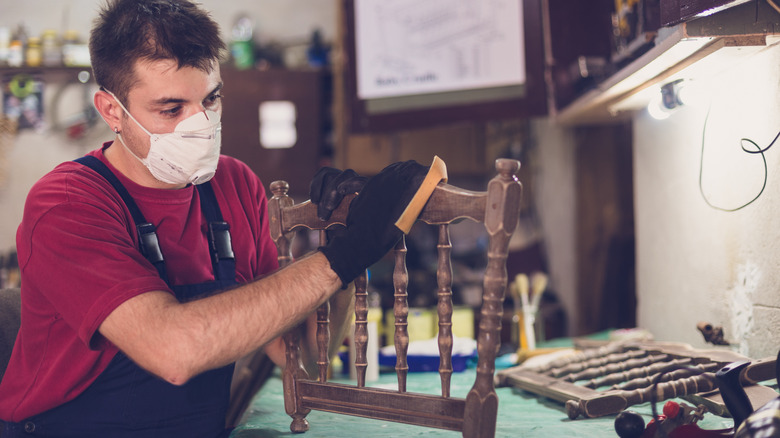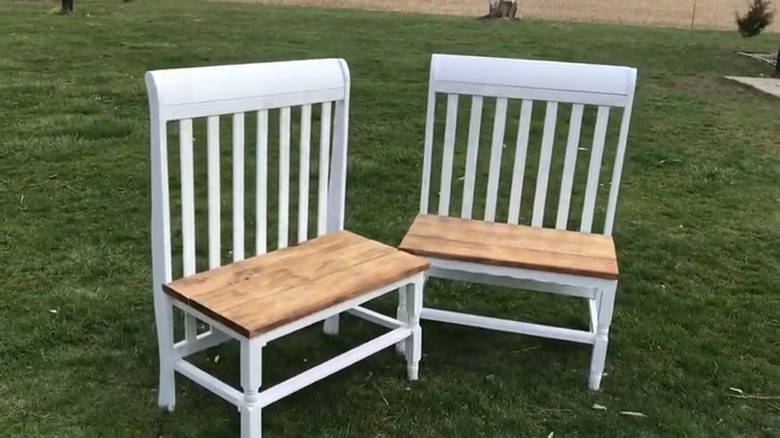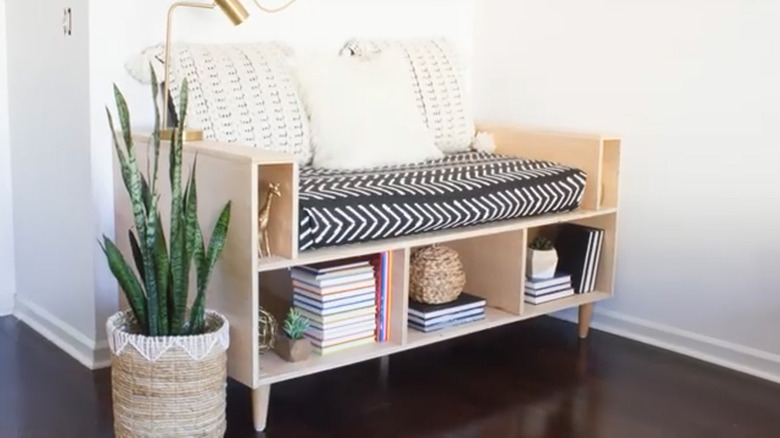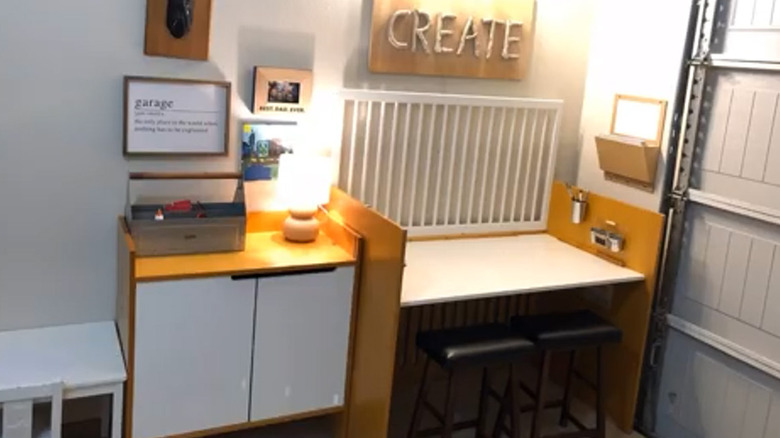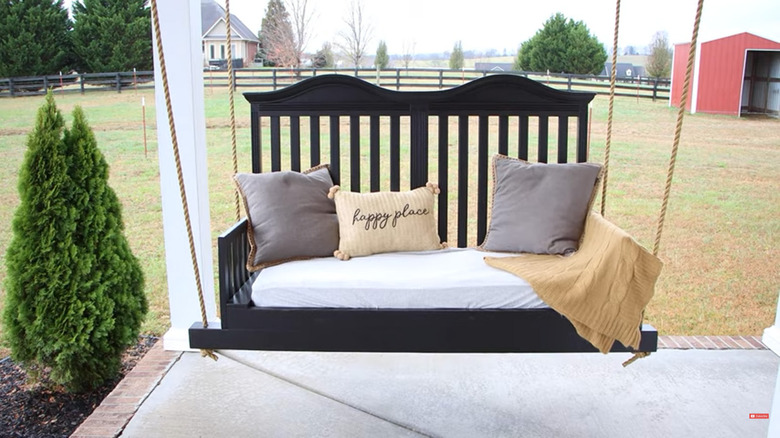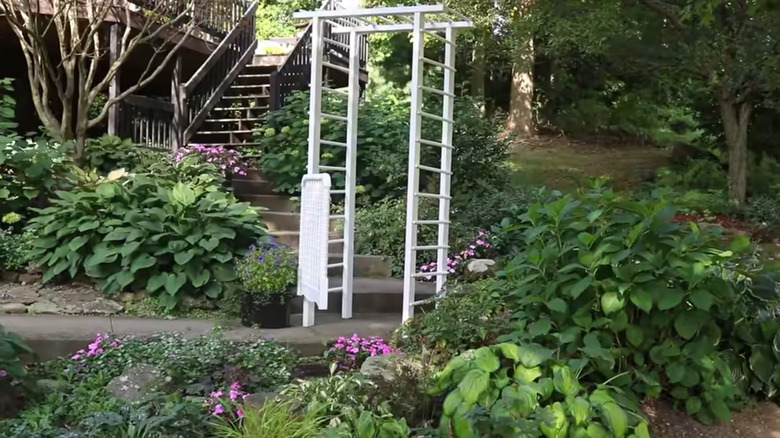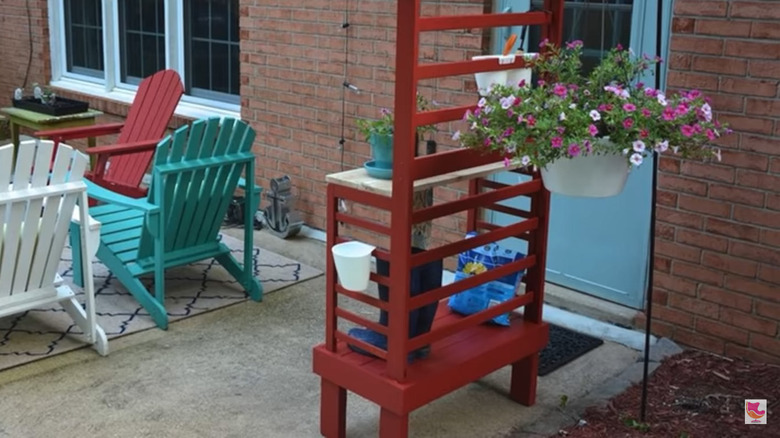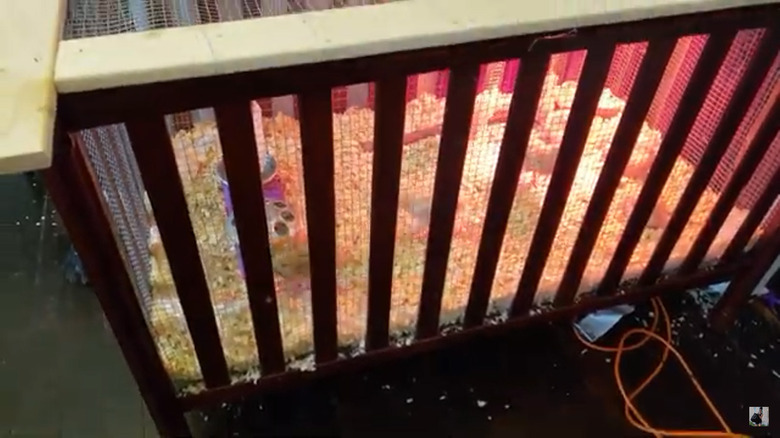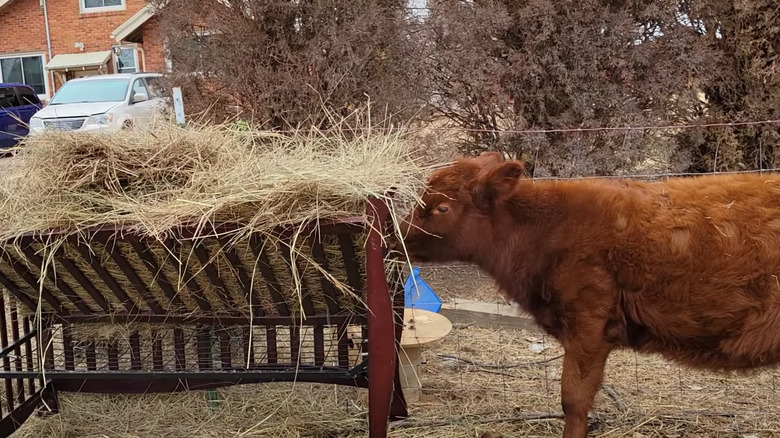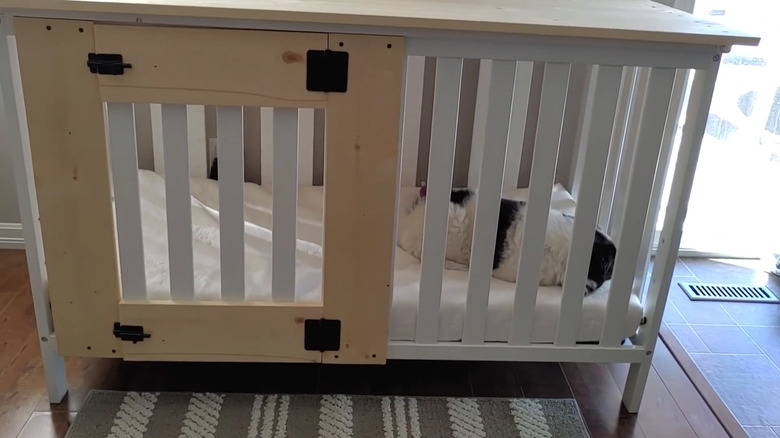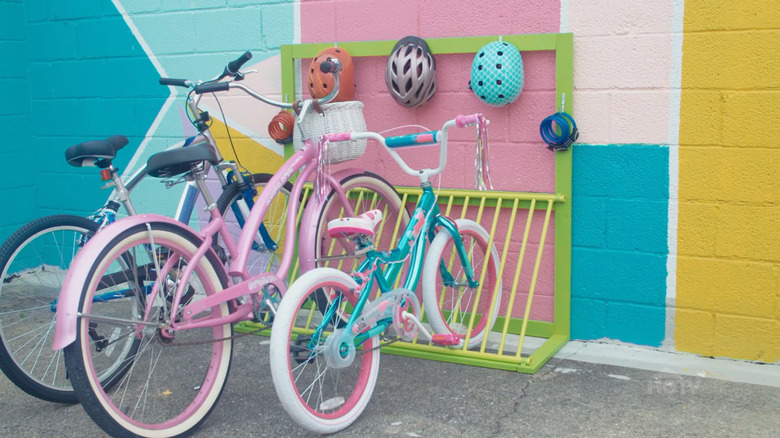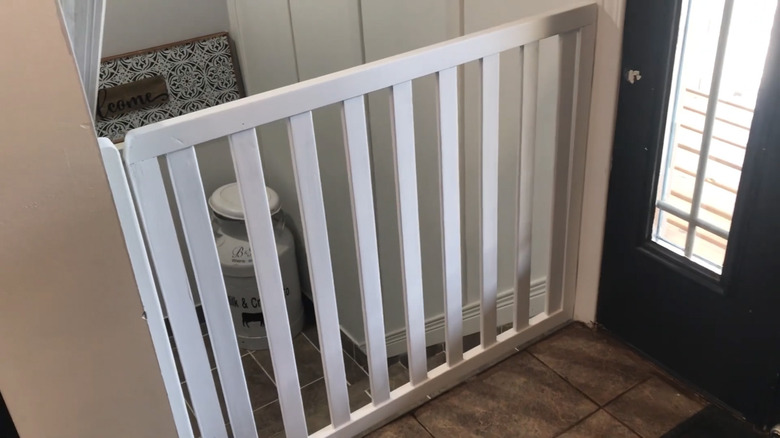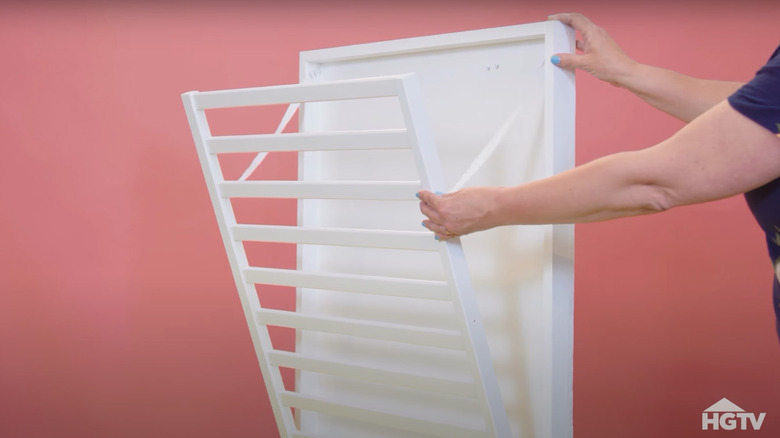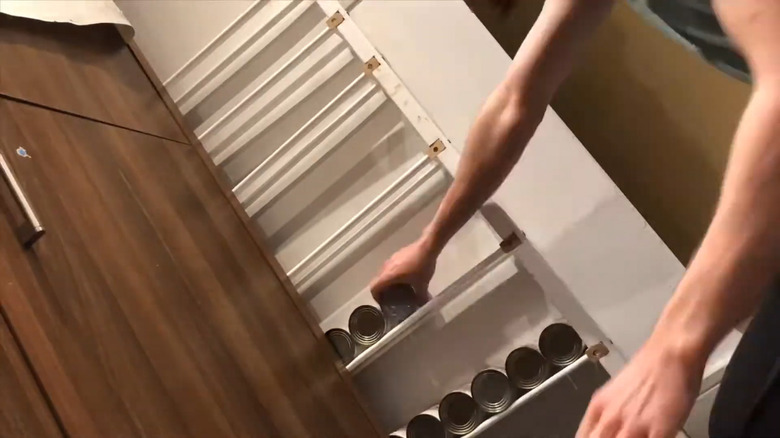Clever Ways To Repurpose Old Cribs
If people, in general, tend to get rid of things before the end of their (the things', that is) useful lives, our culture at large has nothing on parents, who find themselves replacing items like clothing before they're even properly worn in. But shoes and clothes move around fast via mechanisms like community consignment sales and garbage bags full of onesies someone gave grandma. Cribs can be more difficult to unload for several reasons, and we're here to help.
Needless to say, lots of parents don't want to unload their children's cribs and might prefer just to leave the whole nursery in place for a decade or two. But that's a lot of wasted space that most people could make good use of. But because consignment and thrift stores won't typically take cribs, you can quickly find yourself in the position of throwing this sentimental item away... or turning it into something more useful.
Benches
The most popular way to repurpose a crib seems to be transforming them into benches of one sort or another. This is probably because it can be a fairly simple operation. Of course, woodworkers (like craftsmen of all types) can blow right past the point of diminishing returns and make anything difficult, just as crafty people don't always show the proper respect for structural engineering. These projects often manage to keep some of the design elements of the crib intact, which can be a plus when sentimental attachments are involved.
The typical crib-to-bench conversion involves using the back of the crib (the often-taller long side that might go against a wall) as the back of the bench, the shorter sides as bench sides, and often no real front at all. Most crafters build out the seat box themselves, though the metal spring frame can be used (usually supplemented with something like a quarter-sheet of plywood) if the dimensions work out right. One YouTuber, DI4Y Crafts, used the front of the crib as the seat. Sometimes the pieces are adjusted for fit or aesthetics; when the sides are left at full height, the finished piece can see awkwardly proportioned and uncomfortable. Joinery is a major difference in construction styles. Most makers simply screw the various pieces together, perhaps with some wood glue, while woodworker types like Michael Harman Wood Design use more advanced joinery. The important thing, of course, is that the bench holds together.
Because of the way the components are usually cut, the original finish doesn't survive intact and most benches are painted in the end. Some have a different finish on the seat, which looks nice.
Daybeds and Other Beds
Another popular crib project is to transform the little bed into a bigger bed, often a daybed. The concept of a daybed for a child is dangerously close to incoherent to begin with (how many toddlers do you see lounging around and cat-napping?). This is even stranger when the mattress from the too-small crib is reused; if it was too small as a crib, it's probably too small as a daybed. But, in any event, they are very pretty.
The structure of the finished child's bed is usually simple: the back of the crib is used as the bed's headboard, and the front of the crib is used as the bed's footboard. The bed rails will need to be constructed from some non-crib material; YouTuber HowToLou made his from one-by (nominally one inch thick, which actually measures .75 inches) poplar stock. If you need bed slats, you'll have to find or buy those as well.
If your purpose is less sentimental and more a waste-avoidance strategy, you might want to take Erin Spain's approach and simply reuse the crib mattress in a bed project. Mattresses are difficult to pension off, and can be expensive; organic cotton crib mattresses typically cost around $300 and can top $1000. So if you can reuse one, you probably should.
Desks and Art Studios
If anything is less likely than a young child voluntarily napping on a daybed, it's a young child sitting at a desk and working on, say, drawings of bugs and essays about liberating children from the oppression of naptime. Yet desks are also among the most popular projects for reusing old cribs.
Desk projects seem to mostly follow the bench model, reusing whole sections of the crib. YouTuber iAudacious shows how simple this can be, doing almost no modification to the crib itself. She removed the crib's front and added a board (cut to size by Home Depot) as a work surface. In fact, the bulk of the project was in outfitting the resulting piece to look and function like a desk. Depending on the child you're making the desk for, you might need it to be a little taller, or you might need to adjust the height of the components so everything lines up right. Charles Long simply used 2x2 stock to effectively extend the legs on the sides, and used a piece of birch plywood directly on the crib springs as a work surface. Simple and effective!
This is one of those projects you have to interrogate a little in advance to determine if, and how, it suits your needs. Ask questions like: do you need a desk with tall sides? Do you need an ornate desk? Etc.
Porch Swings
If you really want children to make use of something you made with a $10 hacksaw, some wood glue, and a blissful disregard for the effects of rain on untreated wood, this swing is where it's at. Most kids love to swing, and the swingingest place to do it is the front porch.
The usual approach seems to be this: remove the crib's front, use the back as the back of the swing, and construct a sturdy seatbox from 2x4 or similar lumber, to which you'll attach your chains or ropes. Famchez also shortened the slides; crib-height sides can be awkward on a bench or swing. The family made some creative (and occasionally destructive) use of tools and good use of kids to complete the gift for a grandmother.
There are, of course, variations. Out of the Woodwork used the crib's two sides as the back, attaching them to each other side-by-side. Woodshop Diaries offers plans for porch swing beds, a sort of combination daybed and porch swing, that can use either a twin or a crib mattress; no other part of the crib is used.
An Arbor
Children are also perfectly willing to climb an arbor, but this one (like most, really) is designed exclusively to climbing plants. How you go about such a project can be as customized or as simple as you'd like, but a very basic crib-based arbor plan might be something like the White Cottage Company arbor. Basically, the arbor itself is constructed from two-by stock, and spindles from the crib are used to connect the two "arches" together. Then, the back of the crib is used as a gate.
Outdoor projects aren't always suitable for crib upcycling because they are rarely, if ever, really designed and finished for use in any kind of weather. The maker from White Cottage finished her arbor with an oil-based clear coat, which should add to the arbor's useful lifespan, but you'd probably need to refinish it fairly frequently to keep it in good shape... perhaps annually.
A Potting Bench
If you don't have any climbing plants handy, the place to start might be making a potting bench out of that old crib. (Of course, then you'll have to buy another used crib to turn into an arbor later. Or have another kid.)
There are a handful of such crib-to-potting-bench conversions floating around the web, and most of them share a similar basic strategy... one you'll recognize: Remove the front of the crib and put in a work surface. Leave the back in place, and the sides stay the sides. The work surface is added at counter height, and typically a storage shelf is added near the bottom. Neither horizontal surface should really be made from repurposed crib parts, since they will probably be exposed to prolonged moisture.
In building her potting bench, YouTuber Thrift Driving discovered one problem that you should be on the lookout for, no matter what you're building from an old crib. Because of the peculiar fasteners used for mass-market furniture assembly, such as long furniture connector bolts, barrel screws, and the like, items like cribs are prone to include large pre-drilled cavities that can weaken the structure in unexpected places, and cause a screw driven in at the wrong point to fail far more easily than normal. You may need to add extra structure to compensate for this.
A Chicken Brooder
If you keep a flock of backyard chickens, you know how important it is to keep chicks in their own safe, warm space until they're big enough to join the rest of the flock in your chicken coop.
Homestead Dreaming used an old crib as the structure for her DIY brooder. First, she stapled hardware cloth (it appears to be half-inch) to the sides. Next, she made a top for the brooder with more hardware cloth framed with amazingly straight 1x4 furring boards. She covered the particle board bottom with painter's plastic to protect it. So the crib structure itself wasn't modified at all, making this one of the easiest of a bunch of easy repurposing projects.
One note: if you have young children, they will want to occasionally (every 15 seconds or so) play with the chicks. The crib approach is really too deep for little ones to fish chicks out safely, which might be a blessing. And note that the edges of hardware cloth tend to have the highest concentration of stabby points in the known universe, so you don't want kids (or chicks) rubbing against that too often.
A Hay Feeder
Since we've somehow constructed a bit of a hobby farm for you to live on, why not buy a cow so that it will make sense to repurpose your next old crib as a hay feeder? That's what the inexplicably named Dipped In Ranch Farm White House family did. The modifications appear to be minor: the front of the crib is removed and inserted at an angle, with the bottom of the front at the back of the crib and the top more or less in its original position at the front top. This creates a wedge-shaped holding area into which hay for goats and cows goes.
The idea of the device is to hold hay while allowing for drainage, which keeps the hay from rotting. Of course, in the process of creating drainage, this invention is going to get wet itself, and stay wet wherever wet hay is left in the feeder. As a result, this construction is unlikely to survive a season outdoors, so you're going to need another crib pretty soon, and you know what that means. (If you don't know, just watch the chickens for a while.)
Dog Crates
A farm is a field held together by makeshift structures and something very like Stockholm Syndrome, by which animals consent to their captivity instead of being their natural selves, like all the wild cows and chickens. This happy bit of cooperative coercion is also what causes dogs to prefer sleeping in their crates. To get yourself one of these crates, all you have to do is have a child and eventually move it from its crib to a bed shaped like a Formula I car or whatever.
The most basic form is an easy project using a few common tools. Remove some of the vertical slats from the crib's front and attach them to a door frame, which is then attached over the hole you just created. Add a top of some sort and, voila, a dog crate! Depending on your crib's design, you might need to shorten or remove legs so that the mattress sits more or less on the floor, though one puppy managed just fine with short crib legs.
The DIY Network has an even simpler version of this project that will work with some crib designs. Basically, the bottom of the front is detached, leaving the front's top screws to act as hinges. A top is added, and you have a dog crate with the entire front serving as a door.
A Bike Rack
Constructing a bike rack from an old crib is a great project that will never get used, which is just as well because it might not survive the rainy season any better than the hay feeder did. The HGTV version of this project uses the front from a metal crib, which should stand up to the weather reasonably well, but attaches it at an angle to an L-shaped frame made of one-by pine stock. The screws used to strap the crib front to the frame are necessarily less than ¾-inch. Screw holes tend to collect moisture, leading to rot, so small screws like that will soon pull out of their holes.
The HGTV rack was positioned against a cinder-block wall, and it would probably make more sense to attach the bike rack directly to the wall using masonry screws, if you have the tools for that. Another approach might be to use the bike rack in a covered area, so that it's protected against rain to some extent.
A Child Safety Gate
People trying to prevent their children from falling down stairs or climbing up arbors must often resort to modifying a safety gate, since safety gates are universally designed to fit no combination of walls that has ever existed. If you're going to do all that, why not just make your own from scratch? Or from a crib, if you don't want to invest in scratch.
Helena's Craft Barn converts the front and back of an old crib into two child safety gates by cutting them down to fit their openings and simply attaching them to the wall with hinges where gates are needed. No latching hardware is shown or described, and this can be the trick with safety gates. A standard gate latch (the sort of thing you often see on pool gates, usually out of reach from smaller children) will work, for a while, but children will eventually figure out how to operate them. Other options, like barrel bolts or hook-and-eye mechanisms, are functional but tend to be slow to operate. You'll need to find a solution appropriate to your gate design and your child's escaping skills, or rely on the gate mostly as a means of slowing the child down.
Clothes Drying Racks
The slats that make a crib suitable as a safety gate also make it perfect for use as a clothes-drying rack that help you save on your utility bills. HGTV's drying rack project involves using the front (or back, if you prefer) of an old crib as a rack that folds out from the wall slightly at the top, so the slats can be used to hold delicates. The crib front is built into a frame, which is mounted to the wall. The front is attached with small gate hinges at the bottom, and attached ribbons determine how far it's allowed to move from the wall. Magnets keep it secured in the vertical position when not in use.
If you have the wall space for it, this is an easy and handy project for a laundry room. The benefit of a system like this is that it'll save floor space and reduce the amount of laundry-related clutter you might end up dealing with if you use free-standing drying racks.
A Single-Stack Pantry
You probably don't have an enormous amount of free space in your home, what with all the stuff made of cribs sitting around everywhere. This great little hack shows you how to use even the smallest space to store pantry items that you don't mind forgetting about for months at a time.
Timelapsedad cuts the front of a crib into small sections that include two slats and the wood connecting them at top and bottom. These are then attached to a frame and used horizontally to hold canned goods in the space beside a refrigerator. The design is probably more complex than it needs to be, and the assembly process involves what must be a full day of repetitive work, which isn't made easier (or quicker) by the fact that timelapsedad only uses unpowered tools, including an old twist drill. But the finished product is nice-looking and definitely useful, if you have such a space available.
